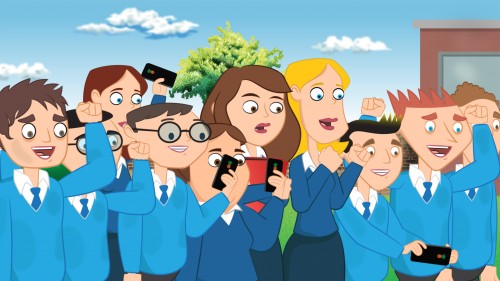Lesson 5: #Up2Us – Agree an Online Code
In Lesson 5, #Up2Us – Agree an online code, students will devise guidelines for taking and sharing photos online and for better internet and technology use in general. While teachers are ultimately responsible for behaviour in the classroom and must not tolerate bullying behaviour, involving pupils in the development of cyber anti-bullying guidelines is likely to have a greater impact on behaviour than simply handing down rules.
- +Curriculum links
- SPHE strand: Myself and others;
SPHE strand unit: My friends and other people – Explore and discuss how individuals can deal with being bullied, knowing that others are being bullied and being a bully.SPHE strand: Myself and the wider world;
SPHE strand unit: Media education – Explore and use some simple broadcasting, production and communication techniques. - +Resources needed and methodologies
- Resources Needed:
– Worksheet 5.1: Our online code
– Worksheet 5.2: Share or delete?–Equipment needed for extension activity: Laptop/PC, access to the school website/social media sites
Methodologies: – Photo analysis, brainstorm, group work, polling.
- +Activity 5.1 – Sign up for a better internet
- STEP 1 – Have the students rewatch some of the animations included in this education pack. The students should then, in groups, reflect on what they’ve learned in the course of the last few lessons.
STEP 2 – Then ask the groups to come up with some guidelines to help prevent cyber bullying and make their community a more inclusive place. Different groups might specifically consider use of mobile phones, tablets, cameras, gaming devices, social networking sites, etc.
STEP 3 – Emphasise to the students that these guidelines should help prevent people from having embarrassing online or cyber bullying experiences.
STEP 4 – After the groups have noted their suggestions on Worksheet 5.1: Our Online Code and these suggestions have been communicated to the whole class, the class should vote on what to include in their code for internet and mobile phone use.
STEP 5 – When the code has been completed it should be recorded.
STEP 6 – Everyone should then sign the code. Students should also take copies of the code home to their parents and have them discuss and sign the code too. It is good practice to display guidelines/rules / rights and responsibilities on the walls of classrooms – see them as the ‘golden rules’ or a “classroom charter’.
- +Activity 5.2 – You’ve been framed
- As the students work independently in groups to complete their guidelines in Activity 5.1, you will probably need to facilitate this activity, Activity 5.2.
STEP 1 – Give each group a chance to review the photos that they took in the previous lesson.STEP 2 – After the students have seen all the pictures they should consider the following questions (also included on Worksheet 5.2: Share or delete?):
Q. Were any of the photos funny?
Q. Were any of the photos embarrassing?
Q. Could the photos get anyone into trouble?
Q. Would you mind if your grandparents or younger siblings saw the photos?
Q. Would you mind it if the photos were shared publicly online?
Q. Would you mind if someone shared the photo publicly, sometime in the future?STEP 3 – If the students answer yes to any of the above questions they may want to consider deleting the picture before it is shared.
STEP 4 – This time should also be used for students to learn how to delete unwanted photos from a digital camera.
- +Extension activity using technology
- STEP 1 – Type up the code for internet and mobile phone use.
STEP 2 – Upload it to the school website/social media sites.






